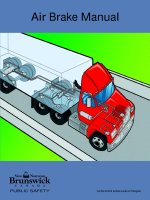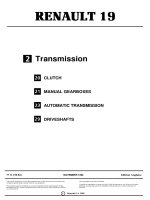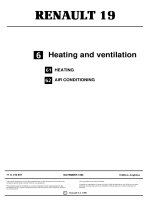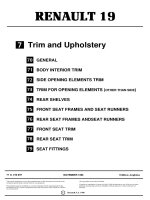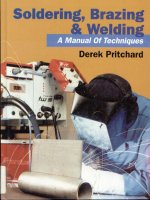Welding manual
Bạn đang xem bản rút gọn của tài liệu. Xem và tải ngay bản đầy đủ của tài liệu tại đây (14.05 MB, 762 trang )
TC 9-237
CHAPTER 1
INTRODUCTION
Section I. GENERAL
1-1.
SCOPE
This training circular is published for use by personnel concerned with welding and
other metal joining operations in the manufacture and maintenance of materiel.
1-2.
DESCRIPTION
a.
This circular contains information as outlined below:
(1) Introduction
(2) Safety precautions in welding operations
(3) Print reading and welding symbols
(4) Joint design and preparation of metals
(5) Welding and cutting equipment
(6) Welding techniques
(7) Metals identification
(8) Electrodes and filler metals
(9) Maintenance welding operations for military equipment
(10) Arc welding and cutting processes
(11) Oxygen fuel gas welding processes
(12) Special applications
(13) Destructive and nondestructive testing
b.
Appendix A
nical manuals and
operations.
c. Appendix B
d. Appendix C
e.
Appendix D
contains a list of current references, including supply and tech–
other available publications relating to welding and cutting
contains procedure guides for welding.
contains a troubleshooting chart.
contains tables listing materials used for brazing. welding.
.
-,
soldering, arc cutting, and metallizing.
f. Appendix E contains miscellaneous data as to temperature ranges, melting
points, and other information not contained in the narrative portion of this manual.
Section II. THEORY
1-3. GENERAL
Welding is any metal joining process wherein coalescence is produced by heating the
metal to suitable temperatures
, with or without the application of pressure and
with or without the use of filler metals.
Basic welding processes are described
and illustrated in this manual.
Brazing and soldering, procedures similar to weld–
ing, are also covered.
1-1
TC 9-237
1-4.
METALS
a. Metals are divided into two classes, ferrous and nonferrous. Ferrous metals
are those in the iron class and are magnetic in nature. These metals consist of
iron, steel,and alloys related to them. Nonferrous metals are those that contain
either no ferrous metals or very small amounts. These are generally divided into
the aluminum, copper, magnesium, lead, and similar groups.
b. Information contained in this circular covers theory and application of
welding for all types of metals including recently developed alloys.
1-2
TC 9-237
CHAPTER 2
SAFETY PRECAUTIONS IN WELDING OPERATIONS
Section I.
GENERAL SAFETY PRECAUTIONS
2-1. GENERAL
a.
To prevent injury to personnel, extreme caution should be exercised when
using any types of welding equipment.
Injury can result from fire, explosions,
electric shock, or harmful agents.
Both the general and specific safety precau-
tions listed below must be strictly observed by workers who weld or cut metals.
b.
Do not permit unauthorized persons to use welding or cutting equipment.
c.
Do not weld in a building with wooden floors, unless the floors are protect-
ed from hot metal by means of fire resistant fabric,
sand, or other fireproof mate-
rial.
Be sure that hot sparks or hot
welding equipment components.
d.
Remove all flammnable material,
vicinity of welding.
metal will not fall on the operator or on any
such as cotton, oil, gasoline, etc., from the
e. Before welding or cutting, warm those in close proximity who are not protect-
ted to wear proper clothing or goggles.
f.
Remove any assembled parts from the component being welded that ma become
warped or otherwise damaged by the welding process.
g.
Do not leave hot rejected electrode stubs,
steel scrap, or tools on the
floor or around the welding equipment.
Accidents and/or fires may occur.
h. Keep a suitable fire extinguisher nearby at all times.
Ensure the fire
extinguisher is in operable condition.
i. Mark all hot metal after welding operations are completed. Soapstone is
commonly used for this purpose.
2-2.
PERSONAL PROTECTIVE EQUIPMENT
a. General.
The electric arc is a very powerful source of light, including
visible, ultraviolet, and infrared.
Protective clothing and equipment must be worn
during all welding operations.
During all oxyacetylene welding and cutting proccess-
es, operators must use safety goggles to protect the eyes from heat, glare, and
flying fragments of hot metals.
During all electric welding processes, operators
must use safety goggles and a hand shield or helmet equipped with a suitable filter
glass to protect against the intense ultraviolet and infrared rays. When others
are in the vicinity of
the arc cannot be seen
the electric welding processes, the area must be screened so
either directly or by reflection from glass or metal.
2-1
TC 9-237
2-2.
PERSONAL PROTECTIVE EQUIPMENT (cont)
b.
Helmets and Shields.
(1) Welding arcS are intensely brilliant lights. They contain a proportion
of ultraviolet light which may cause eye damage.
For this reason, the arc should
never be viewed with the naked eye within a distance of 50.0 ft (15.2 m). The bril–
liance and exact spectrum,
and therefore the danger of the light, depends on the
welding process, the metals in the arc, the arc atmosphere, the length of the arc,
and the welding current.
Operators, fitters, and those working nearby need protec-
tion against arc radiation.
The intensity of the light from the arc increases with
increasing current and arc voltage.
Arc radiation, like all light radiation, de–
creases with the square of the distance.
Those processes that produce smoke sur-
rounding the arc have a less bright arc since the smoke acts as a filter.
The
spectrum of the welding arc is similar to that of the sun.
Exposure of the skin
and eyes to the arc is the same as exposure to the sun.
(2) Being closest, the welder needs a helmet to protect his eyes and face
from harmful light and particles of hot metal.
The welding helmet (fig. 2-1) is
generally constructed of a pressed fiber insulating material.
It has an adjustable
headband that makes it usable by persons with different head sizes. To minimize
reflection and glare produced by the intense light, the helmet is dull black in
color. It fits over the head and can be swung upward when not welding. The chief
advantage of the helmet is that it
hold the work and weld at the same
leaves both hands free, making it
time .
possible to
(3). The hand-held shield (fig. 2-1) provides the same protection as the hel-
met, but is held in position by teh handle. This type of shield is frequently used
by an observer or a person who welds for a short period of time.
(4). The protective welding helmet has lens holders used to insert the cover
glass and the filter glass or plate. Standard size for the filter plate is
2x4-1/4 in. (50x108 mm). In some helmets lens holders open or flip upwards.
Lenses are designed to prevent flash burns and eye damage by absorptiion of the
infrared and ultraviolet rays produced by the arc. The filter glasses or plates
come in various optical densities to filter out various light intensities, depend-
2-2
ing on
of the
the welding process,
lens, usually green,
intensity of white light or
type of base metal, and the
blue, or brown, is an added
glare.
Colored lenses make
TC 9-237
welding current.
The color
protection against the
is possible to clearly see
the metal and weld.
Table 2-1 lists the proper filter shades to be used.
A magni-
fier lens placed behind the filter glass is sometimes used to provide clear vision.
A cover plate should be placed outside the filter glass to protect it from weld
spatter.
The filter glass must be tempered so that is will not break if hit by
flying weld spatter.
Filter glasses must be marked showing the manufacturer, the
shade number, and the letter “H” indicating it has been treated for impact resis-
tance.
2-3
TC 9-237
2-2.
PERSONAL PROTECTIVE EQUIPMENT (cont)
NOTE
Colored glass must be manufactured in accordance with specifications
detailed in the “National Safety Code for the Protection of Hands and
Eyes of Industrial Workers”
, issued by the National Bureau of Stan-
dards, Washington DC, and OSHA Standards, Subpart Q, “Welding, Cut-
ting, and Brazing”, paragraph 1910.252, and American National Stan-
dards Institute Standard (ANSI) Z87.1-1968, “American National Stand-
ard Practice for Occupational and Educational Eye and Face Protection”.
(5) Ga
S metal-arc (MIG) welding requires darker filter lenses than shielded
metal-arc (stick) welding.
The intensity of the ultraviolet radiation emitted
during gas metal-arc welding ranges from 5 to 30 times brighter than welding with
covered electrodes.
(6) Do not weld with cracked or defective shields because penetrating rays
from the arc may cause serious burns.
Be sure that the colored glass plates are
the proper shade for arc welding.
Protect the colored glass plate from molten
metal spatter by using a cover glass.
Replace the cover glass when damaged or
spotted by molten metal spatter.
(7) Face shields (fig. 2-2) must also be worn where required to protect
eyes. Welders must wear safety glasses and chippers and grinders often use face
shields in addition to safety glasses.
(8) In
Helmets with
some welding operations,
the use of mask-type respirators is required.
the “bubble” front design can be adapted for use with respirators.
2-4
